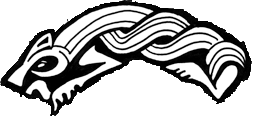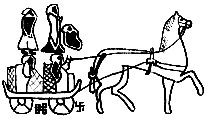ANGLO-SAXON ART presents itself in their metalwork, jewellery, manuscripts and sculpture and the influence of the Celts, Christianity and the Vikings, all contributed towards the differing styles.
| Quoit-Brooch Style Found chiefly in Kent and the south-east, the crouching quadruped is seen in profile while the double contoured body is covered with a fur detail of slight incisions and occasionally has spiral hips. The lips form an outward curved line with an often open mouth. |
 |
| Style I The zoological reality of the animals becomes more of a pattern with a mass of confusion of heads, legs, tails and teeth covering every available space on the surface. |
 |
 |
| Style II/Ribbon Style Scroll patterns and foliage motifs appear with a development of the previous style. Ribbon like bodies of animals and snakes nterlace and interplay and animal and tendril ornament covers every surface with some animals degenerating into foliage. There is still no realism and symmetry is adhered to or abandoned at will. |
 |
|
 |
 |
|
Fusion Style
A gentle mixture of styles I and II fusing both the disjointed and interlaced patterns.
Polychrome
Originating from Kent and East Anglia, polychrome jewellery is most commonly presented as disc brooches and there are two distinct standards. The first is the most luxurious and uses a base plate of gold or silver, built up with bands of metal into gold or silver cells (cloison), with flat-cut stones and coloured glass set into them.
Between the cells are panels of filigree-wire ornament and the item’s border may also be made up with filigree. In order to add sparkle to the flat stones, the cells may be lined with a small piece of stamped foil, that reflects the light at different angles.
The humbler type is found with the base plate and cells cast in one piece, with a serrated edge imitating the filigree. The cells are still filled with garnets but the coloured glass rarely occurs.
Celtic
The relics of the Sutton Hoo ship burial (7th century) and the Lindisfarne Gospels (about 690 British Museum, London) have typical Celtic ornamental patterns, demonstrating a love of intricate, interwoven designs.
Christianity
In the manuscripts of southern England, in particular those produced at Winchester and Canterbury, a different style emerged in the 9th century, with delicate, lively pen-and-ink figures and heavily decorative foliage borders.
| Trewhiddle Animals and other ornamental motifs defined by shallow carving, are speckled with the corner of the engraving tool, as the Trewhiddle horn mounts (below) demonstrate. |
 |
 |
 |
 |
|||
VIKING ART is presented through six main styles and these are listed below with a general idea of their time period.

| Broa/Oseberg 22 gilt-bronze bridle mounts from a male grave in Broa, Gotland, were covered in curvaceous animals with small heads and a multitude of tendrils – traditional Scandinavian artistic style. However, on a few of these mounts appeared a new style of animal; the gripping beast, so called because its paws grip itself, another or the frame surrounding it. |
 |
|
| From the royal ship burial at Oseberg, Norway we have the ship, wagon, sledges, bedsteads and animal-head posts and we can see that the gripping beast motif has fully developed while there remains the traditional, controlled, design of gently curving animals. |  |
|
| Borre Bronze bridle mounts found in the Norwegian ship burial in Borre, Vestfold reveal the evolved gripping beast, with its mask-like animal head, ribbon like body and ever present gripping paws. Examples have been found that were produced in Russia, England and Iceland, demonstrating the extent to which the style spread across the Norse world. |
 |
| Jellinge The silver cup found in the Danish royal burial chamber in Jellinge, Denmark has the S-shaped animals with intertwined ribbon bodies forming an open interlace pattern, with heads in profile, pigtail and curling upper lip that are distinctive Jelling style characteristics. |
| Mammen The battle axe found in a grave in Mammen, Jutland shows a more naturalistic proportioned body has developed and the beginning of foliate patterns, as on the axe. A development of body infil is evident with the increase in size and a human mask can be seen on both the axe and the Bamberg casket. |
 |
| Ringerike The Alstad stone from Ringericke, Norway demonstrates a much greater use of foliate and tendril patterns and much more realistic images of birds, horses and dogs, but we can still see an enormous use of spiral hips. |
 |
| Urnes Woodcarvings found at the little church of Urnes, Norway show extremely stylized animals are being used, their heads and feet elongated terminals, though still with the spiral hips. The foliate patterns have evolved into thin ribbons snaking their way around and ending in a bud-like device. |